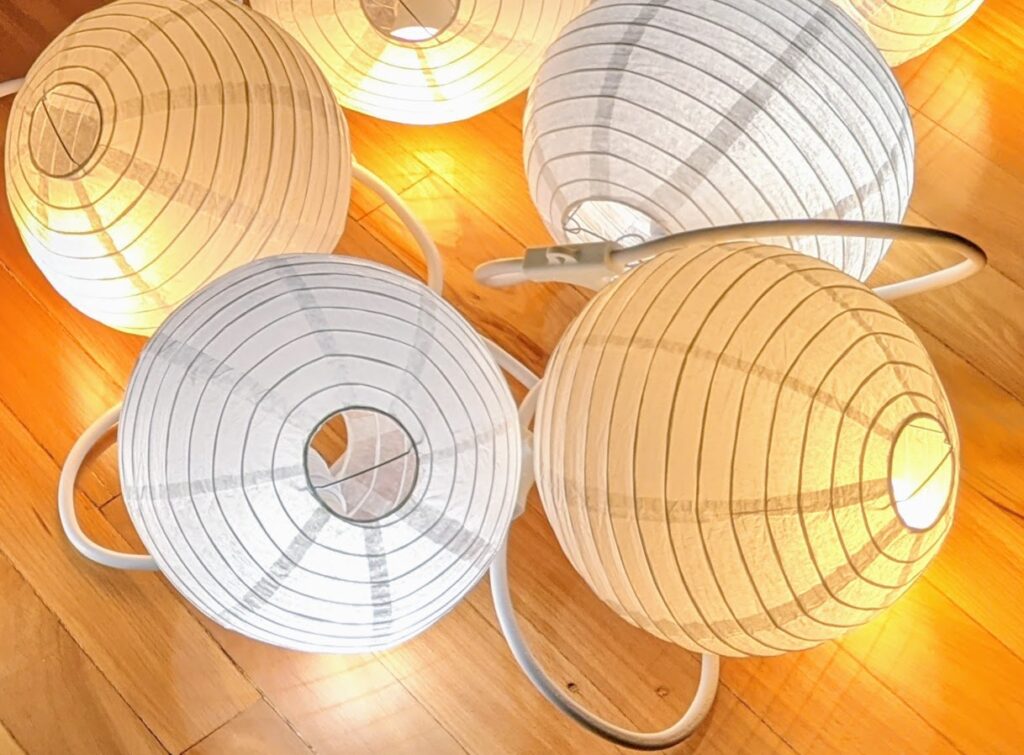
Inspired by a friend’s post, I set out to build my own version of a Lumenator, a device to flood a room with light in order to prevent the sadness of a dark winter and Seasonal Affective Disorder (SAD).
I found a couple of instructional pages, but most have not been updated for a while, so I’m doing my own writeup here in hopes that it might help people source materials and build their own.
My version has strands of 10 lights, each using a 100W equivalent LED bulb, covered in paper lantern shades to better diffuse the light. The strands are hung on my apartment walls with heavy-duty adhesive wall hooks.
Materials for each strand:
- 1 x 10-socket light stringer for E26 base bulbs (normal Edison screw sockets). I chose one with suspended bulbs to make attaching lanterns easier. Non-suspended versions are fine also.
- 5 x 100W-equivalent (1600 lumen) LED bulbs, 5000K (daylight) color, size A19, with CRI 90+
- 5 x 100W-equivalent (1600 lumen) LED bulbs, 2700K (warm white) color, size A19, with CRI 90+
- 1 x 14-pack of Command large utility hooks (17003-MPES), each holds up to 5lb
- Optional: 10 x 8-inch diameter spherical paper lamp shades
- Optional: Smart plug that allows app/voice control of the strand
Cost of supplies for one 10-light strand for me: $140
- $34 – 10-light stringer
- $42 – 5000K 100W LED bulbs
- $29 – 2700K 100W LED bulbs
- $16 – Command hooks
- $9 – paper lamp shades
- $10 – smart plug
Lumens per strand: 10 bulbs * (1600 lumens / bulb) = 16,000 lumens
Building a strand:
- Put the LED bulbs into the sockets on the light stringer. It’s a bit of a tight fit with the weathertight seal on the strand I picked out, so it takes a bit of force to screw on. Alternate colors of the bulbs, 1 warm white (2700K), then 1 daylight (5000K), and so on.
- Plug in the stringer to test that all the bulbs light up.
- For me, none of the bulbs worked. I contacted support at the Paper Lantern Store and they suggested I should try gently pulling out the contact tabs at the base of each socket a bit to make sure it’s contacting the bulbs – make sure to do this with the string unplugged if you do! That worked for me.
- Optional: Add a paper lantern cover to each bulb if you choose to use them. For the suspended socket cord I chose, I could thread the top of the suspended wire through the metal lantern holder so the bulb stays in place on the lantern.
- Hang up the adhesive hooks on the wall – it helps to have a friend here so you can hold the strand up where you want it and get the hooks positioned properly. Wait to hang the strand up, since the hangers probably need time to set up before they’ll hold weight.
- Optional: Attach a smart plug to the strand so you can control the light by app or voice.
- Hang up the light strand after the hooks have set up, and enjoy!